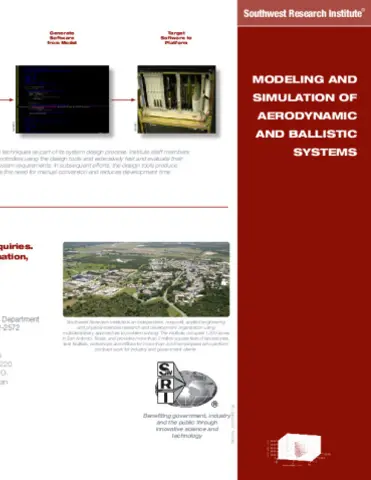In modern warfare, the tactical and accurate delivery of weapons is paramount. Guided weapons and guidance accessories for modern aircraft have improved the accuracy of weapon systems; however, many legacy aircraft continue to deliver free-fall ordnance with degraded accuracy.
Accuracy errors can be offset by pilot adjustments and improvements to the weapon model within the onboard ballistic computer, but confirmation of the model improvement is currently limited to flight test and ballistic algorithm analysis. Flight test is an expensive technique and proprietary data restrictions limit the effectiveness of software analysis.
Southwest Research Institute (SwRI) has been providing engineering solutions in support of ballistics for more than 25 years. SwRI has capabilities and experience in all stages of ballistics including interior, exterior, intermediate and terminal ballistics. SwRI applies its diverse engineering expertise and facilities to answer challenges to the accurate delivery of non-guided, free-fall ordnance and provide alternative solutions to flight test and algorithm analysis.
SwRI engineers apply model-based design techniques to develop ballistic models, design weapon scoring algorithms, and test real-time software. SwRI staff evaluate fire control avionics with a mission replay tool which includes a hardware-in-the-loop (HIL) simulation. Previous efforts have included redesign of avionics hardware. Staff members perform design and development under ISO 9001:2000-compliant processes.
Aircraft Flight and Ballistic Modeling
Capabilities
- Autopilot and 6-DOF aircraft model for HIL simulation
- 3-DOF (degrees of freedom), modified point mass, and 6-DOF weapon models
- Atmospheric conditions (wind) and translation between reference frames
- Image generation using GraIL™ (DTED and UMC) and open source software
- Mission replay tool incorporated into HIL simulator
- Sensitivity analysis and data reduction toolset as subset of mission replay
- Weapon delivery evaluation toolset as subset of mission replay
Experience
- Investigation of generic ballistic scoring
- HIL simulator
- Propulsion upgrade program evaluation of ground collision avoidance system (GCAS)
Real-Time Software
Capabilities
- Green Hills Integrity
- RTOS Linux
- Wind River Vx Works
- Ada
Experience
- Improved electronic processor unit for A-10 turbine engine monitor
- A-10 HIL simulator
Avionics Simulation Hardware
Capabilities
- VME hardware interface to digital and analog avionics ports
- Flight control with stick and throttle
- PC workstation with avionics bus interfaces
- Virtual instrumentation readouts
- PXI/PCI capable configuration
- Oversized video display
- Video display mixed with stroked symbology
- Proprietary and open source image generation
Experience
- Redesign of LASTE (A-10 fire control computer) circuit cards
- Redesign of engine monitoring avionics
Software Languages
- Ada
- C/C++
- MATLAB®
- Simulink®
- Java®
Multidisciplinary Staff
- Ballisticians
- Modeling and control engineers
- Training and simulation engineers
- Aerospace engineers
- Software engineers
- Statisticians
- Electronic hardware design engineers
- Mechanical design engineers
- Avionics technicians
- Systems engineers
Facilities
- 10-acre outdoor facility with 12 designated test sites on the SwRI grounds in San Antonio, Texas
- Test facility for small arms testing (up to .50-caliber)
- Indoor range for small compressed gas guns (bore diameters 0.1–3.0 inches)
- Test site for large-scale experiments approximately 60 miles southwest of San Antonio
- Personnel and laboratories at additional sites available to provide ballistics support
- HIL laboratories


